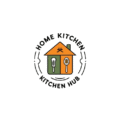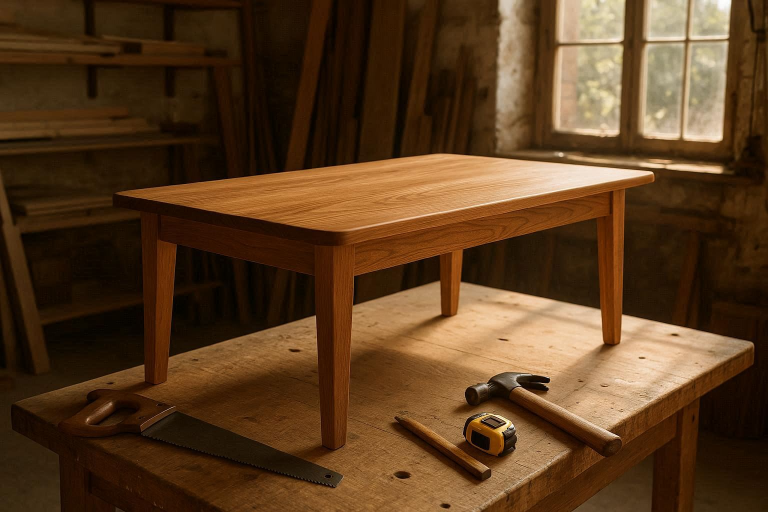If you’re looking to add a personal touch to your kitchen or dining room, making your own kitchen table is an incredibly rewarding project. Not only will you save money compared to buying a pre-made table, but you’ll also get the satisfaction of creating something uniquely your own. Plus, DIY tables are incredibly versatile; whether you’re crafting a simple kitchen table or a grand dining table, the process is manageable with the right tools and a bit of patience.
In this guide, we’ll walk you through the step-by-step process of making a kitchen table and show you how to customize it to suit your style. From choosing the right materials to finishing touches, we’ve got you covered!
Why Make Your Own Kitchen Table?
There are plenty of reasons why making a kitchen table can be a great DIY project. Let’s dive into the main benefits:
Personalization: Tailoring Your Table to Fit Your Kitchen Style
When you build your own table, you have full control over its design. Whether you want a rustic farmhouse table or a sleek modern look, Ideas for Kitchen and Living Room making your own kitchen table allows you to choose materials, shapes, sizes, and finishes that perfectly complement your kitchen or dining space.
You can even incorporate extra features like storage underneath, or make the table extendable for larger gatherings. With a DIY project, the possibilities are endless!
Cost Savings: A Budget-Friendly Alternative
Buying a pre-made kitchen table can be expensive, especially if you’re aiming for a high-quality piece that fits your space and style. By making your own table, you can significantly cut down costs. Many DIYers use reclaimed wood or less expensive plywood, which helps reduce the overall cost of the project. If you’re on a tight budget, this is an excellent way to get a stylish and functional table without breaking the bank.
Satisfaction: The Joy of Crafting from Scratch
There’s something incredibly satisfying about creating something with your own hands. You can proudly say, “I built this table!” when guests sit down for a meal. DIY projects provide a sense of accomplishment, and you’ll likely treasure your homemade table for years to come.
Materials Needed to Make a Kitchen Table
Before you begin, you’ll need the right materials and tools to ensure your project goes smoothly.
Wood Options
Choosing the right wood is crucial for your table’s durability and appearance. Here are some common wood options:
- Solid Wood: Oak, maple, and pine are popular choices for table construction due to their strength and aesthetic appeal. Oak is particularly sturdy, while maple is smooth and easy to work with.
- Plywood: Plywood is a more budget-friendly option. While it may not have the same natural beauty as solid wood, it’s a great choice for beginners and can be painted or stained to match your decor.
- Reclaimed Wood: Using reclaimed wood adds character to your table. You can often find old barnwood or wood from pallets, which can give your table a rustic, vintage look.
Tools Required
Here’s a list of essential tools for making a kitchen table:
- Saw (a circular saw or jigsaw works well for cutting wood)
- Drill and screws
- Wood glue
- Clamps
- Sandpaper or an electric sander
- Measuring tape
- Wood finish (stain, paint, or varnish)
Finishes and Paints
The finish you choose will determine the final look and durability of your table. Staining or painting the wood can add beauty and protect it from wear and tear. Varnishing is also an option for a glossy, polished look. Be sure to choose a finish suitable for kitchen use, as this area is subject to spills and heavy usage.
How to Make a Kitchen Table Step by Step
Now that you have your materials and tools ready, let’s break down the process of building your kitchen table.
Step 1: Plan and Measure Your Table
First, decide on the dimensions of your table based on your kitchen space and intended use. If you’re building a small breakfast table, a round or square table may be ideal. For a family dining table, consider a rectangular shape.
Use a measuring tape to plan out the size of the tabletop and the length of the legs. Don’t forget to leave some extra space for comfortable seating.
Step 2: Cut the Wood Pieces
Once you’ve got your measurements, it’s time to cut the wood. You’ll need to cut the tabletop, legs, and any support pieces, such as an apron (the frame that goes around the edge of the table).
When cutting, make sure to use a saw that’s appropriate for your wood type. If you’re using solid wood, a circular saw or jigsaw is ideal. Be sure to measure carefully and make straight cuts for a professional finish.
Step 3: Assemble the Table Frame
To start assembling, attach the legs to the apron using screws and wood glue. The apron helps stabilize the legs and gives the table strength. If you’re making a larger table, it’s important to reinforce the joints by using corner braces or additional cross supports.
Ensure everything is level as you assemble, as a crooked table will not be sturdy.
Step 4: Sand and Smooth the Surface
Sanding is a crucial step to make sure your table is smooth and free from rough edges. Use an electric sander for quick work or sand by hand for a more controlled finish. Start with a coarse-grit sandpaper to remove large imperfections, then move to a finer grit for a smooth, polished surface.
Step 5: Apply Finishing Touches
Once your table is sanded and smoothed, it’s time to add a protective finish. Apply wood stain, paint, or a clear varnish to bring out the beauty of the wood. Let each layer dry completely before applying the next. You may need to apply multiple coats, depending on the finish.
Step 6: Final Assembly and Inspection
After the finish has dried, attach the tabletop to the frame. Ensure the screws are tight and everything is securely in place. Give the table a final inspection to check for any wobbling or unevenness. If everything is stable, you’re done!
How to Make a Simple Dining Table
If you’re looking for a quick and easy project, a simple dining table is a great option. For beginners, consider using plywood for the tabletop and basic wooden legs. The design can be minimal, with just a rectangular tabletop and four straight legs. Finish the table with a stain or paint of your choice to add personality.
How to Make a Dining Table Top
The tabletop is the focal point of your kitchen table. For a durable and beautiful surface, consider joining multiple planks of wood using techniques like butterfly joints or edge gluing. These methods ensure that the planks are securely attached while providing a seamless look.
Sanding the surface smooth is essential to avoid any rough spots. You can use a router to round off the edges for a more polished look.
How to Make a Long Dining Table
Building a long dining table requires extra consideration for stability. You’ll need to use thicker wood for the tabletop and reinforce it with cross beams or extra leg supports. When determining the dimensions, ensure there’s enough space for everyone to sit comfortably without overcrowding.
A long table will also need strong joints and support structures to prevent sagging in the middle over time.
DIY Table for Beginners
If you’re a DIY newbie, start with a simple four-legged table. Rectangular or square designs are easiest for beginners to assemble. You can use plywood for the tabletop and add wooden legs or pre-made table legs for a quick setup. This project is straightforward and budget-friendly.
How to Make a Cheap Kitchen Table
Building a kitchen table doesn’t have to be expensive. Use inexpensive wood like plywood or reclaimed wood, and keep the design simple. Skip the fancy finishes and opt for a natural wood look that’s easy to maintain. You can also repurpose old furniture to create a unique table, saving money and reducing waste.
How to Build a Table: Key Considerations
When building your table, keep a few key considerations in mind:
- Stability: Make sure the joints are secure, and add cross supports if necessary to prevent wobbling.
- Size: Choose dimensions that fit your space while ensuring ample seating room.
- Design: Whether you’re going for a modern, rustic, or industrial look, make sure the design complements your kitchen or dining room.
How to Make a Kitchen Table Out of Wood
If you’re using wood for your table, solid woods like oak, maple, or pine are great choices. These types of wood are durable and look great when stained or varnished. To ensure your table lasts, treat the wood to protect it from moisture and stains—especially important in a kitchen setting.
How to Make a Kitchen Table from Scratch
Making a table from scratch gives you the ultimate freedom in design. Start with raw lumber and plan out each step carefully. From measuring and cutting to sanding and finishing, building from scratch allows you to create a table that fits your needs perfectly.
How to Make a Kitchen Table Easy
If you’re looking for an easy way to make a kitchen table, use pre-cut wood and simple tools. This will save you time on cutting and allow you to focus on assembling and finishing the table. Using screws and clamps will help ensure everything stays in place while you work.
Additional Tips for DIY Table Projects
- Safety: Always wear protective gear, including goggles and gloves, when working with wood.
- Avoid Mistakes: Make sure your cuts are straight, and double-check measurements before cutting. Weak joints can cause instability.
- Maintenance: Regularly check for wear and tear. Tighten screws and reseal the surface as needed.
FAQ
What type of wood is best for making a kitchen table?
Hardwoods like oak and maple are excellent choices for their durability and appearance. Pine is cheaper and easier to work with but may dent more easily.
How long does it take to make a kitchen table?
It can take anywhere from a few days to a week, depending on the complexity and drying time for finishes.
What tools do I need to build a kitchen table?
Basic tools include a saw, drill, measuring tape, screws, and clamps.
Can I make a kitchen table without using power tools?
Yes, hand tools like a handsaw and screwdriver can be used for basic tables, though power tools will speed up the process.
How do I make sure my kitchen table is sturdy?
Use sturdy joints, reinforce with cross beams, and make sure the legs are securely attached.
How much does it cost to build a kitchen table?
Costs can range from $50 to $500+, depending on the materials and tools you already own.
Can I create a dining table from old furniture?
Absolutely! Repurpose wooden doors, old tables, or pallets for a rustic look.
Conclusion
Building your own kitchen table is a rewarding experience. It allows for creativity, customization, and cost savings. Whether you’re crafting a simple table or a long dining piece, the satisfaction of creating something functional and beautiful from scratch is well worth the effort. So gather your materials, grab your tools, and start building your own kitchen table today!

